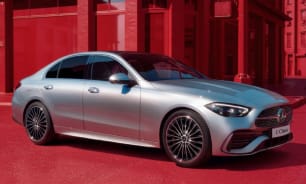I'm not going to lie – there are sedans out there that have an almost limo-like space inside but the C200 isn't one of them.
It's not small by any means and all occupants enjoy the comforts of decent legroom and headroom but it's not cavernous considering the specs (1437mm high/1820mm wide/4751mm long).
The optional panoramic sunroof does cut into the headroom for back seat passengers, which is something to consider if your family is very tall.
The storage is maybe a tad leaner-than-average for a car of this size. The glove box and middle console aren't massive but will suffice.
The cupholders up front can be removed if you need extra storage space for larger items and back seat passengers enjoy retractable cupholders in the armrest.
The way the front doors curve out creates a larger than normal storage bin and drink bottle holder – which help make up the difference. There is a dedicated phone pocket, to tuck it out of the way.
The boot space is 455 litres (VDA), which isn't as large as some others on the market but it was plenty big enough for my family's needs.
There's a handy under-floor storage pocket for smaller items, like the puncture repair kit, because you don't get a spare tyre in this.
When it comes to ease of use, my six-year-old loved not needing my help to get into his seat and he still enjoyed a decent view out of the wide back window.
The amenities in each row are good but not class-defining. Still, creature comforts have be well-thought through.
Front occupants enjoy heated seats and fantastic lumbar and under thigh support. Dual-zone climate control sorts out the temp, and the cool circular air vents that make loud audible 'clicks' when manoeuvred give the interior a jet cockpit vibe.
While I've never had an issue opening or closing a sedan boot, the powered lid was a nice feature to have this week.
The tech throughout is great and intuitive to use. The massive 11.9-inch touchscreen multimedia system is cool and is easy to use once you become acclimatised to Mercedes system.
The customisable digital instrument panel makes the driving experiences feel individualised.
The interior is a chilled out space with gentle scrolling touchpads taking the place of most 'push' buttons and dials.
Think of each surface as being a bit like a touchscreen tablet in how you operate it. I was a little worried the touchpads would be laggy but they're very responsive.
There's only one USB port in the whole car, which limits charging for other passengers but I did enjoy the easy connectivity of the wireless Apple CarPlay.
The electric heated front seats are a nice touch but I was amused by the 'kinetic' function on both. It's what you might call a 'massage' function on another car but here they don't really work. It's best to think of them as a way to do some (very) gentle stretching on a long trip.
The 360-degree camera view is super clear and crisp but the dynamic guidelines (which tilt the camera angle) are a bit too dynamic for my liking and I relied mostly on the bird's eye view to park.
As I've mentioned, the ambient lighting system creates a stellar atmosphere inside. I've often wondered why other car manufacturers haven't jumped on that bandwagon because it's a relatively cheap way of creating wow factor. And it generates massive wow factor in here.






































































































